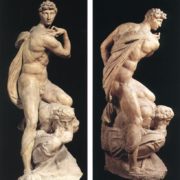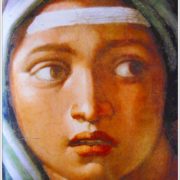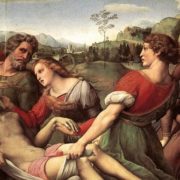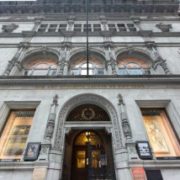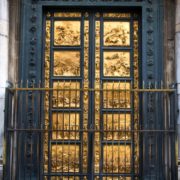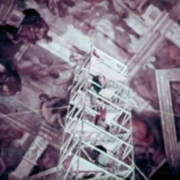City of Florence to Charge Admission at Santa Maria Novella
By James Beck
Should churches charge admission fees to see art?
The recent decision by the city of Florence, with the approval of the Superintendent of Fine Arts (Soprintendente ai beni artistici) of Florence Dr. Antonio Paolucci together with church authorities to charge admission to visit Santa Maria Novella has raised a host of questions pertinent to the culture as a whole. One should keep in mind that this is by no means the first time churches in Italy (and elsewhere) charge entrance fees. At the top of a growing list is, after all, the Vatican which for decades has been requiring a fee or really a ticket to visit the Sistine Chapel. Of course the Vatican is not Italy. And strictly speaking and with considerable finesse, the Sistine Chapel has been defined as part of the Vatican Museums and by so doing any ethical ambiguities have been effectively sidestepped. Museums customarily, though not universally, have been selling admissions for centuries.
The same ‘solution’ has been applied to the Brancacci Chapel in Santa Maria del Carmine in Florence, more recently, following an extensive not to say brutal restoration of the frescoes by Masolino, Masaccio and Filippino Lippi. In this instance the comune of Florence, museum-ized the chapel, lumping it together with the little museum that was always there. Furthermore they eliminated an entry to the Brancacci Chapel from the church itself, effectively eliminating its religious connection. As with the Sistina, the fiction was reinforced that one was not actually paying to enter a church, but rather a museum.
The situation surrounding entrance to the Baptistery, Dante’s bel S. Giovanni, with encrusted marble decoration outside and glistening late Medieval mosaics inside, is slightly different. The tourists must now pay to visit the unforgettable building which stands in the piazza of the Duomo, across from its façade and Giotto’s bell tower. The same has been true for decades at Pisa’s Piazza dei Miracoli where Cathedral authorities have been collecting entrance fees for their marvelous buildings: the Camposanto, the Duomo, the Baptistery. The holy buildings are grouped with the Museum of the Works of the Cathedral and the Museum of the Sinopia on a “cumulative ticket,” for which there is a discount off individual admissions.
Now the Dominican church of Santa Maria Novella in Florence, located a stone’s throw from the train station from which its name derives, will have an admission fee amounting to 5,000 Lire (about 2.50 in Euros). The art in the church and in the cloister is of the highest quality and rivals that in most public museums. Chief works of Cimabue, Giotto, Orcagna, Masaccio, Ghiberti, Brunelleschi, Filippino Lippi, Ghirlandaio, and Paulo Uccello are here. The decision to reclassify the building, in modern jargon, into a “chiesa-museo,” results from two events: the clean up which was conducted for the Jubilee and the restoration and repainting of Masaccio’s unequaled Trinity, painted in late 1425 or 1426.
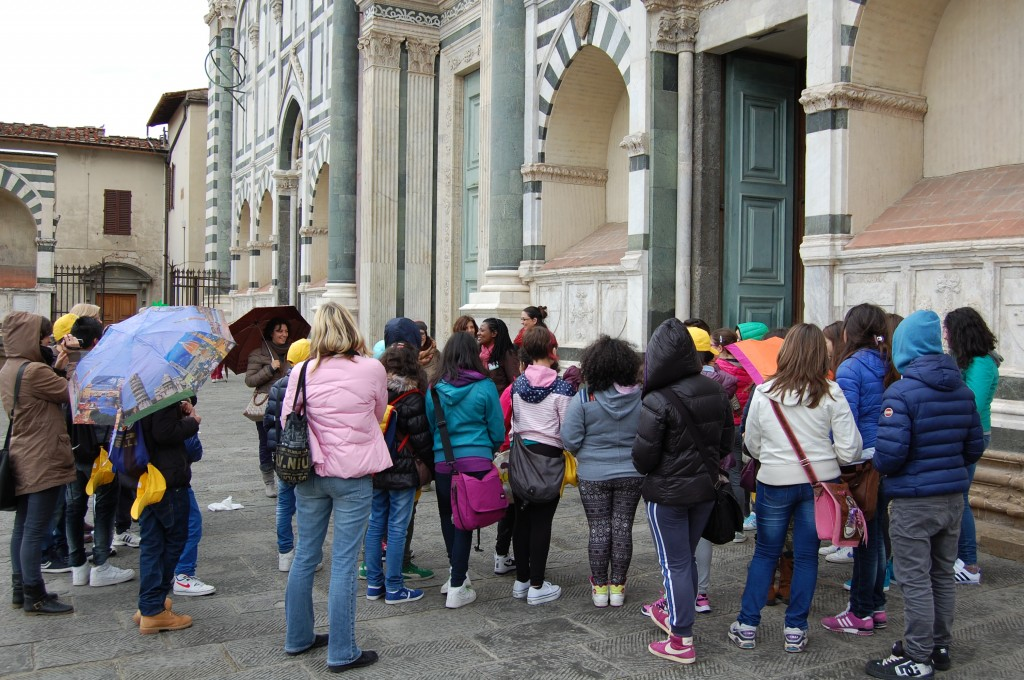
Once the total cleaning of the Brancacci frescoes across the river in Santa Maria del Carmine had been completed in 1988, and probably not for the first time, the fame-hungry sponsor (who has since disappeared from the restoration scene) was anxious to become associated with the restoration project of the Trinity, so as to monopolize the Masaccio market. The intervention was postponed until 1999, when officials, taking advantage of the fact that the church was closed in preparation for the Jubilee, moved ahead. Now the fresco will be ready for tourists again. In retrospect it seems almost inevitable that the same fate would await the Trinity and the church itself as the Brancacci Chapel.
Masaccio’s Trinity fresco is, in terms of the history of art and the history of culture, extremely influential. Here for the first time we find a thorough explication of the new perspective, along with the rendering of monumental human figures of decided gravity. The spatial complexity of the Trinity continues to amaze and baffle even the most sophisticated critics. In the Trinity, for the first time, profile portraits of the donors are rendered on a large scale. For good reason, then, the Trinity is featured in all general histories of art as a seminal painting, surely worth the price of admissions: half the cost of a movie or a sit down coffee at Rivoire.
But the ethical question remains to be confronted: should churches charge admission at all? This apparently simple question encapsulates diverse elements. First of all ownership needs to be established. Who owns the artistic treasures of the past? Actually in the fifteenth century, the Florentine government provided quarters for several popes at Santa Maria Novella, and there too Michelangelo and Leonardo da Vinci prepared their cartoons for the battle murals for the Palazzo Vecchio at the beginning of the following century. Does Santa Maria Novella belong to the Holy Roman church in the larger sense, or to the particular order, in this case the Dominicans, or, perhaps, to the Florentine commune which provided funding? What about the Italian state; or better yet, the entire world?
The city of Florence has assumed the right to create a not-for-profit company (“un’associazione senza fine di lucro called Opera Santa Maria Novella”). As for the state, de facto authority has been assumed by the Superintendent of Fine Arts who reluctantly signed onto the new system. The rarity represented by Santa Maria Novella begins with the facade which was designed by Leon Battista Alberti, sufficient on its own to make it qualify as a world treasure. So far, looking at it is free. Surely, Masaccio’s Trinity stands out even in the most august company but so does Brunelleschi’s rare wooden Crucifix and Orcagna’s unrivaled Strozzi Altarpiece. Thus the inclination persists to advocate world ownership. As things now stand, the Italian government has a good deal of authority, because after all, at least the responsibility for the treatment of the building and its contents, and in the case of the restoration of the Trinity, lies with the government. The issue of ownership requires serious debate.
But if the ownership of Santa Maria Novella represents a thorny issue, the need for an injection of funds is obvious and represents another path for inquiry. The building is visited by thousands each day during the “season,” although Santa Croce in Florence probably has more. [Will this church soon follow?] Such traffic requires every category of maintenance, supervision, guards, cleanup, restorations. Then we can imagine a modern, fully stocked shop which is a sine qua non in every museum worthy of the name these days. Unquestionably the tiny group of Dominican Friars has an overwhelming burden. In other words, they need the financial relief, and if possible generate some income from their treasures. I realize that an infusion of funds would be highly welcomed and necessary. So, gentle reader, you may quite properly ask what is all the fuss about; why am I raising the issue at all?
For an answer, let us return momentarily to the Brancacci Chapel. The frescoes there have been an informal academy for artists since they were painted, and were studied by Leonardo, Michelangelo, Raphael and Cellini who regarded them as a kind of touchstone for art. Even after World War II, artists and art students continue to slip into the Carmine virtually as a ritual to pay their respects to Masaccio, who in his short life had altered the course of art. All that has ended partly because no one wants to get in line, get a ticket, pay, and be admitted for a short and finite visit, en masse.
What is the proper conduct for such institutions as Santa Maria Novella? How should the culture approach the question? It seems to me that one approach is that related to education. Very few would deny that the provision of an education, up to the age of sixteen or eighteen or even through university, is the responsibility of the commonwealth, the state, the constituted society. Such a responsibility rests at the very heart of state, like health care, road building, providing for defense and protection of its people. Perhaps art should be placed into this same equation. In Italy, where art is ever present, one could make a persuasive case. To be sure, the central government already does take on many responsibilities over art, especially in terms of its care, which includes restoration. Should we expect that government accept the responsibility of keeping a church-museum like Santa Maria Novella open, functional and free?
If the state is unable to do so, for whatever the reasons, one might expect that the European Union might be called upon to step in. A perfectly good case can be made to preserve the “free” status of the rare objects housed in the church.
And if all the avenues of various levels of government fail, payment in the form of a voluntary contribution might be instituted which removes the onus of a mandatory fee. After all among the visitors are relatively penniless artists, art students, younger travelers, tourists with families, and those who might wish to come back again and again, as the Trinity of Masaccio demands.
A true cultural debate seems to be in order.

